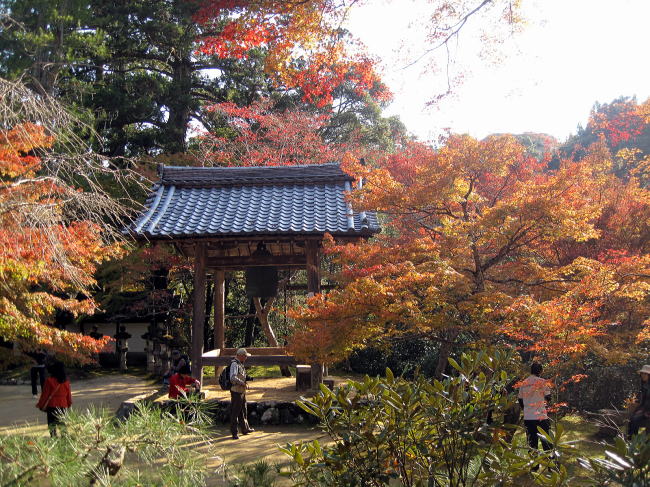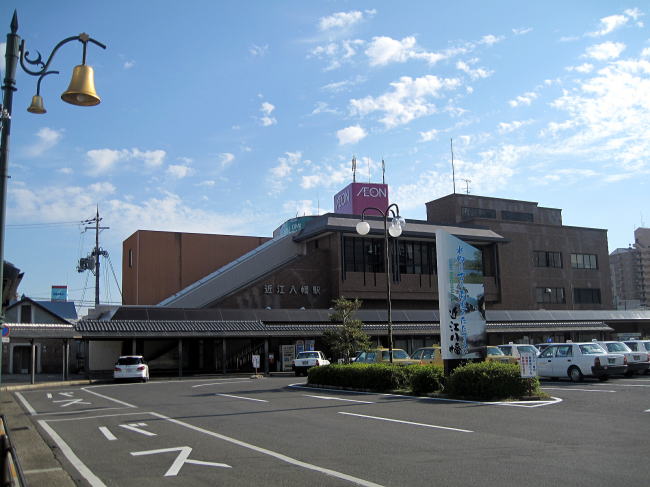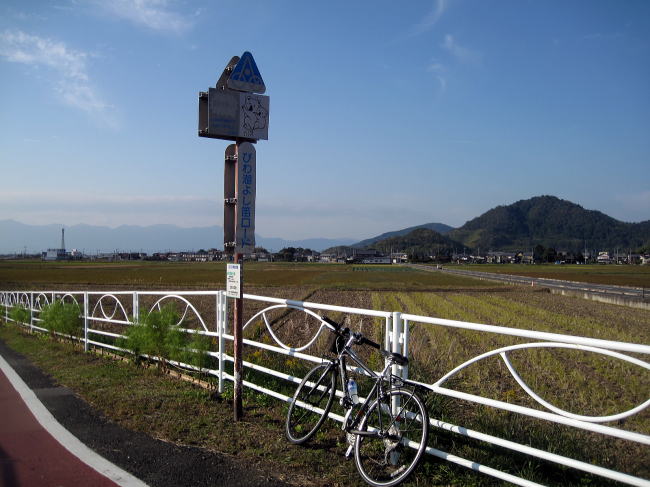Weekly Topics/Archive
November 2011
|
The design of my desktop wallpaper is red maples this month.
The foliage season has just come.
I went out for leef-viewing, having been tempted by red maples on the desktop.
Since it was a fine and warm day with a temperature of 20 ℃ as was forecasted yesterday, I left home
before 9 a.m.
By the way, why is “momiji-kenbutsu” called “momiji-kari” ?
( Momiji-kenbutsu means leef-viewing in English. )
I have thought this word strange until now.
The word “kari” was originally used when people hunted animals and gathered
or picked plants, wasn't it?
For example, usagi-kari (wild rabbit hunting), inoshishi-kari (wild bour
hunting), shika-kari (deer hunting)
and etc as for animals.
And kinoko-kari (mushroom gathering), ichigo-kari (strawberry picking),
budou-kari (grape picking)
as for plants.
Their aims are to gain hunting products.
So I checked the origin of a word “momiji-kari.”
The word “kari” originally meant hunting and then was also used as the meaning of gathering plants,
and later, came to be used as the meaning of viewing flowers.
And the word “momiji-kari” has been used as the meaning of leef-viewing.
I understood it !
At the start of leef-viewing, I just wanted to know the meaning of it.
As it let me clear my head, I can go to see the colorful autumn leaves.
My destinations are Jingo-ji Temple, Kozan-ji Temple and Saimyo-ji Temple,
which are located
in the district of Takao, Toganoo and Makinoo which are titled “Sanbi”,
in the northwestern area of
Kyoto.
They are famous for their finest views of autumn leaves.
Generally speaking, it was the best time to view autumn foliage in Sanbi.
The representative picture of autumn leaves in each temple is as below.

Around the temple gate of Takaosan Jingo-ji Temple |

Around the kaisando (also called the Founder's Hall) of Toganoosan Kozan-ji
Temple |

Around the belfry of Makinoosan Saimyo-ji Temple |
It was a gracious day for me.
For details, please visit the following web pages.
They are full of colorful pictures.
 Picture / Pilgrimage to old temples / 高雄山・神護寺へ紅葉狩り(Japanese) Picture / Pilgrimage to old temples / 高雄山・神護寺へ紅葉狩り(Japanese)
 Picture / Pilgrimage to old temples / 栂尾山・高山寺へ紅葉狩り(Japanese) Picture / Pilgrimage to old temples / 栂尾山・高山寺へ紅葉狩り(Japanese)
 Picture / Pilgrimage to old temples / 槙尾山・西明寺へ紅葉狩り(Japanese) Picture / Pilgrimage to old temples / 槙尾山・西明寺へ紅葉狩り(Japanese)
The pedometer on my mobile phone showed that walk count was 16,700 steps
and walking distance
was 8.6 Km.
I walked a lot, didn't I ?
[Note] leef-viewing ; 紅葉狩り,wallpaper ; 壁紙, maple ; カエデ、 wild boar;イノシシ
see the colorful autumn leaves / view autumn foliage ; 紅葉狩りをする
Founder's Hall ; 開山堂、 belfry ; 鐘楼、 gracious ; 優雅な、風流な
pedometer;歩数計,walk count;歩行数
Japanese Diary / No.404−2011.11.17 / 「京都・三尾へ紅葉狩り」 Diary / No.404−2011.11.17 / 「京都・三尾へ紅葉狩り」
Today is the first weekday in November.
I did the job of “tachiban”, which is a routine work as the road-safety
committee of neighborhood association, for about an hour from 7:20 a.m.
at an intersection near my home.
It was a clear autumn day.
When I was doing the job, I thought it's a shame to stay indoors on such
a fine day.
I really thought it's a perfect weather for cycling.
I have not gone for a cycle ride for some time.
If it is decided to do that, better now than later.
The destination is the Biwako-yoshifue Road which I have long wanted to
cycle along.
I simulated the route from home to the Road by the use of LatLongLab, while
having a breakfast of
toast and coffee.
According to it, the distance is about 38 Km each way and it takes about
two and a half hours.
Since I found I don't have to stay overnight somewhere, I left home at
10 a.m. after changing into cycling
wear.
The cycling route is as below.
After I got to Sadanami Kaido which is a cycle road along Lake Biwa,I
headed straight for
Omihachiman City.
At the lakeside area, silver grasses were flapping in the wind and cosmoses
were blooming.
They were typical autumn senery under the fresh air.
It was just before noon when I entered Omihachiman City, passing by the
windmill in the Karasuma Peninsula in Kusatsu City, in front of Biwako
Ohashi Bridge in Moriyama City and through Yasu River
in Yasu City.
When I rode my bike for a while from there, I could see the “Cyomyouji
Temple” signpost.
I decided to drop by there.
It seemd the temple is on the top of Mt.Cyomyoji.
According to the owner of the souvenior shop, it takes 808 steps to get
to the temple and about 40
minutes to go there and back.
I don't have enough time to do so.
I remembered today's purpose is to enjoy cycling.
And so I stopped visiting the temple and turned back.
My bike was already traveling here on the Biwako-yoshifue Road.

Wataraibashi-kitazume intersection |
After riding my bike along the Cyomyoji River, I turned right at Wataraibashi-kitazume
intersection
and then followed the signpost “Machinami-suigo-nakasendo course”.
When I got into the countryside, I could see the riverside district.
There was a boat pier for Omihachiman Suigo-Megri Riverboat Tour on the
shore which reeds grow
in clusters.
The landscapes of waterside areas were really idyllic.
I pedaled my bike towards an old urban area following the signpost.
I enjoyed pottering to Omi Brotherhood Senior High School, Hakuunkan, a statue of Vories,
a history museum run by Omihachiman city and old streets in which Omi merchants had once lived,
in that order.

A statue of Vories |
William Merrel Vories is well-known for his engaging in architectural
design for a lot of western-style buildings in many part of the nation
after he came to Japan to be an English teacher of the Shiga
Prefectural Commercial School (currently Omihachiman Commercial High School) in
the 38th year
of the Meiji Period.
In the Sengoku period, the age of Civil Wars, Toyotomi Hidetsugu opened
a castle town at the foot
of Mount Hachiman.
In those days, Lake Biwa was the water traffic artery which many cargo
boats were sailing.
Hachimanbori canal was built to make all of them call at the port of Hachiman.
There stands some Shirakabe-dozo (white-walled storehouses) and old houses
along Hachimanbori canal.
In the canal, a boat for Hachimanbori cruise was moving slowly.
It seems to be an ideal spot for amateur painters and photographers.
Along Shinmachi Street near Hachimanbori canal, there remain old homesteads of many Omi
merchants and the old landscape of the town was retained.
As there are many narrow alleys around here, the bike is good for those
who want to take a walk.
You can enjoy different scenery than usual.
I got hungry.
And so I went straight ahead on the street with a fancy name, "Boomerang
Street to get to JR Omihachiman station.

The view in front of JR Omihachiman station |
It was 2:20 p.m. when I went into a restaurant near the station.
I still have to bike to my place in Kusatsu.
I had a hamburger with two mug of beer for lunch to maintain my stamina.
I started from the restaurant for my place at 3 p.m.
After biking on the Biwako-yoshifue Road along Shiratorigawa River flowing
across the countryside,
I got to the Sadanami Road along Lake Biwa.

Biwako-yoshifue Road along the Shiratorigawa River |
After that, I pedaled my bike very hard to get to my place before sunset.
On the way home, I could see the view like this on the lake.

The view on Lake Biwa |
I arrived at my place at 5:01 p.m.
This means it took just about 2 hours from Omihachiman.
Since this was my first long-distance cycling in a while, I really had
sore muscles in my leg.
My cycle computer gave me today's mesurement data as below.
・Elapsed Time ; 4 hours 20 minutes
・Trip Distance ; 75.6 Km
<ifr・Average speed ; 17.4 Km/hour
|
Many other photos of today's cycling are also posted on the Web below.
Please click a link to look at them.
 Picture / Cycling / 「びわ湖よし笛ロ−ドをサイクリング」 Picture / Cycling / 「びわ湖よし笛ロ−ドをサイクリング」
[Note] neighborhood association ; 町内会, tachiban ; 立ち番
road safety committee ; 交通安全委員、stay indoors ;家にとじこもっている
better now than later ; 善は急げ, Biwako-yoshifue Road ; びわ湖よし笛ロ−ド
each way ; 片道、 don't have to do 〜 ; 〜しなくてもよい、 head for 〜 ; 〜に向かう
change into 〜 ; 着替える, silver grass ; ススキ, flap in the wind ; 風になびく
“Cyomyouji Temple”signpost ; 長命寺の案内標識、 there and back ; 往復で
signpost ; 案内標識、道標、 riverside district ; 水郷、 reed ; 葦(ヨシ)
Omihachiman Suigo-Megri Riverboat Tour ;近江八幡水郷めぐり、 grow in clusters ; 群生する
idyllic ; のどかな,牧歌的な,urban area ;市街地、 in order ; 順に、 architectural design ; 建築設計
homestead;家屋敷、 Shirakabe-dozo (white-walled storehouse) ; 白壁の土蔵、 retain ; 保持する
the Sengoku period, the age of Civil Wars ; 戦国時代、 castle town ; 城下町
Toyotomi Hidetsugu ; 豊臣 秀次, traffic artery ; 交通幹線、 cargo sailboat ; 荷船
call at a port ; 寄港する,alley ; 小道,路地,mug of beer ; ジョッキ一杯のビ−ル
Japanese Diary / No.400−2011.11.01/ 「びわ湖よし笛ロ−ドでサイクリング」 Diary / No.400−2011.11.01/ 「びわ湖よし笛ロ−ドでサイクリング」
 TOPペ−ジへ戻る TOPペ−ジへ戻る
|
|